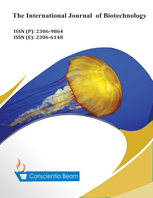Insecticidal Activities of Five Medicinal Plant Materials against Callosobruchus Maculatus Fabricius (Coleoptera: Chrysomelidae) Infesting Cowpea Seeds in Storage
DOI:
https://doi.org/10.18488/journal.57.2018.71.64.69Abstract
Powders from five elite plant materials (nutmeg, Myristica fragrans; red hot chilli pepper, Capsicum annuum; ginger rhizome, Zingiber officinale; black pepper, Piper nigrum and alligator pepper, Aframomum melegueta) at 1.5 % w/w concentration were assessed against cowpea bruchid, Callosobruchus maculatus infestations on stored cowpea seeds under laboratory environmental conditions in three agro-ecological zones in Nigeria by members of the Research Group. The conventional synthetic insecticide, permethrin was included as standard check, while untreated seeds served as the control. Adult mortality, oviposition rate and adult emergence were the indices considered in the experiments. For the first three days of exposure, black pepper (P. nigrum) powder caused the highest percentage mortality (68.8, 78.0 and 83.8 % respectively) of the bruchid adults and differed significantly (P < 0.01) from the rest of other treatments with the exception of permethrin that caused 78.8, 85.0 and 91.3 % mortality respectively. Similarly, black pepper powder and permethrin treatments differed significantly (P < 0.01) from the rest on number of eggs laid and emerged adults with the exception of Z. officinale rhizome, which did not differ significantly from P. nigrum on number of eggs laid. The results therefore suggest that black pepper powder has higher insecticidal potential over other plant materials and could serve as a biotechnological substitute to the synthetic insecticides in the control of C. maculatus infestations and damage in stored products.

